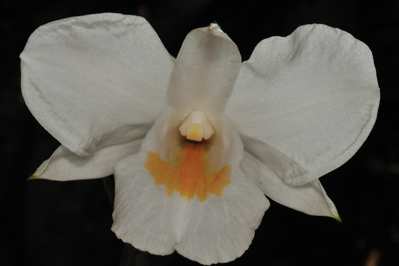Epiphyte. Stems erect, 10 to 18 cm long and 1 to 2 cm in cross section, cylindrical, slightly narrowed to the base. Leaves alternate, sessile, oblong, the apex notched, 5 to 8 cm long and 1 to 2 cm in width. Flowers large, sepal and petals pure white, lip white with an orbicular yellow marking on its disc extended to the base in the form of a ridge. Sepals very narrow, oblong-lanceolate, acute, spreading, the lateral ones very slightly keeled. Petals much larger than the petals, sub-orbicular. Lip broadly obovate, side lobes indistinct, terminal lobe dilated, apex very broad.

The Pursuit
This species bears the largest flowers of all Dendrobiums of the region and the flowers are very attractive too. Sir. Joseph Dalton Hooker in his iconic work, “The Flora of British India” noted about three varieties of this species. I never came across this species on any of my flower hunts. The region were I lived was famous for many flower nurseries and got a good collection of many species. Still, this species remained missing, with no information available with anyone about its habitats, other than, “At the base of Sikkim-Himalayas” noted by Sir. George King and Robert Pantling. The flowering season was mentioned as May, in their monumental work on orchids. With the eagerness to see this species in bloom I planned my surveys to the plains of the Himalayas in the early summer days. The plains are generally of active Tea estates, which produces thousands of tons of Tea every year. The estates are full of activities with thousands and thousands of workers involved everyday. They got their own hospitals, schools, accommodations, roads, shopping centers etc. However, as a general rule they don’t cut any trees and those trees host a lot of tropical epiphytic orchids also. I decided to concentrate on those trees inside the estates for this species. Every day I came across a lot of workers and showed them the drawings of this species, to ascertain if anybody had come across this plant. Working on those plains under the open sky in the summer months of March and April was a very tiring affair. Moreover, my base station was at an altitude about 4000 ft, where the climate was very moderate and comfortable. Every day in a matter of 3 hrs drive I am in the plains where the temperature soars above 40C, which was like stepping inside a hot furnace. However, the desire to find this plant and a feeling that I will get this species in that season itself made me visit various estates in the plains continuously for several days. Every day I returned with no trace of this species but with many admirers, who were so happy to know about my passion. One day I came to know about a former manager of a tea estate who got a good collection of tropical orchids of the area. A visit to his home made be so happy, he had around 140 tropical orchids in his garden, a few of them were in full bloom also. However, my purpose of visit was not fulfilled, the species I am looking for was not found there. I enquired with him about the species I am looking for. He was so happy with my work and explained to me about all those species he had seen and collected from the region, including the one I was looking for. He was also having that species till few years back, it died because of some reason. But, he helped with sufficient information about the place from where his gardener brought it some 30 years back. The next day I started my new search in the area he mentioned. Most of the trees there were more than 50 to 60 years old, so I was sure I will find the plant I am looking for. After three continuous days of survey with the help of a few friends we found 7 plants of this species, 3 in buds. It was like the plants were waiting for me. All the plants were on the sides of tall trees at around 15 to 20 ft height. Climbed up those trees with buds to ascertain the identity and the time required for the buds to bloom. Waited for 11 days to see the first flower in bloom. My vehicle was sent to bring the former manager to that place, as I wished he should also be part of the documentation process. Without his advice, I might not have surveyed those areas and would have never seen the species also. Everything was perfect, the climb, the wind, the placing of flashes etc and produced a wonderful photograph of the species. Those days were so hot, I spend more money on buying drinking water for me than to the fuel for my vehicle!!!.